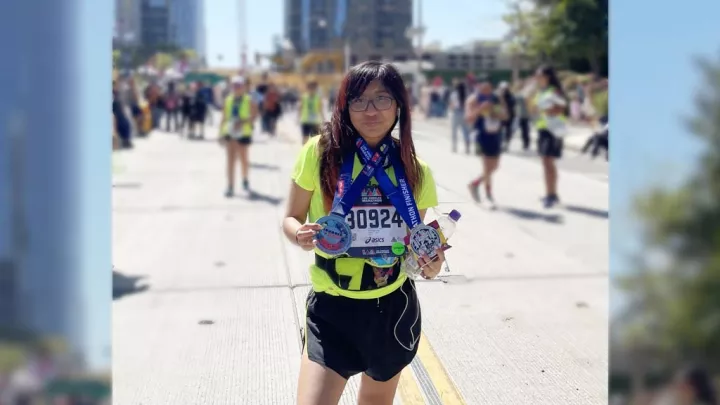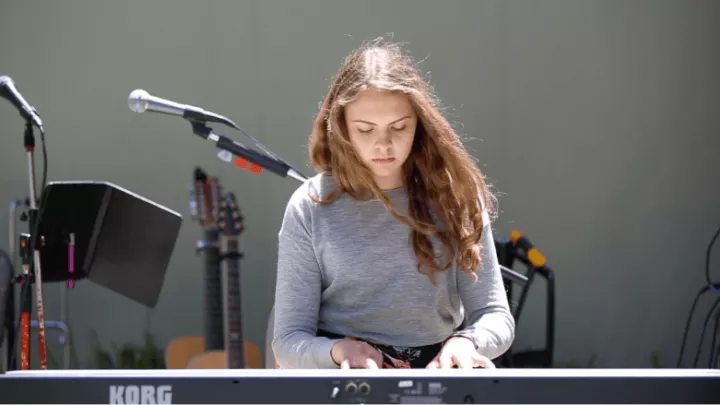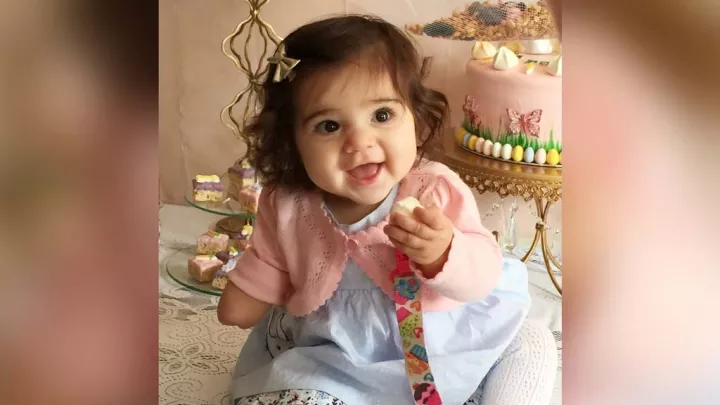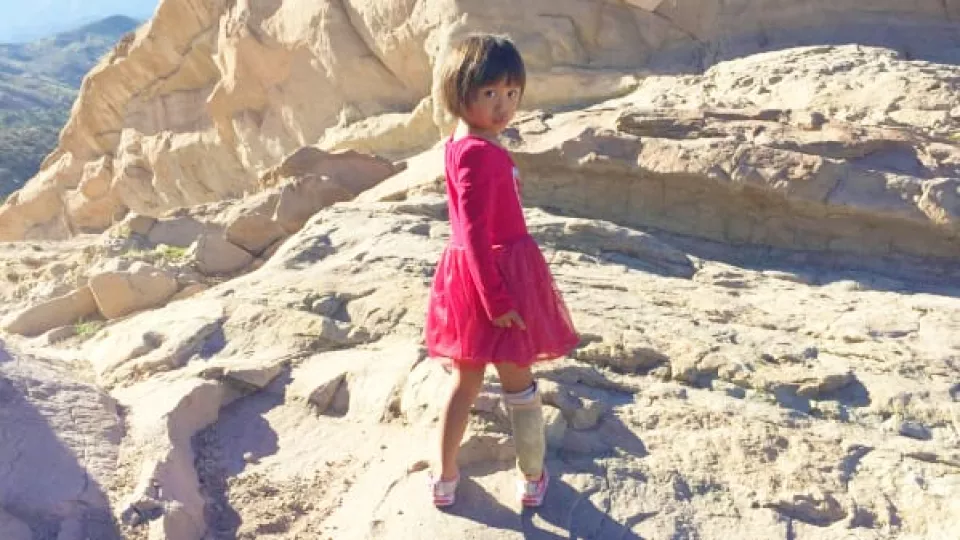
The Unstoppable Fiona Ashe
Don’t believe what Fiona Ashe may tell you. Her parents did not purchase her at Target, though after hearing that claim enough times, her mother finally agreed to it.
“Two weeks ago in the car,” Angie Ashe says, “she was like, ‘Where did you buy me from?’ I just kind of chuckled. ‘We didn’t buy you from anywhere. Do you mean where were you born?’ ‘No, where did you buy me?’ I couldn’t answer her correctly. I kept saying, ‘You were born in China; we adopted you.’ Finally, I said, ‘You want me to say we bought you from Target?’ She just smiled. ‘Yeah, you bought me from Target.’ OK!”
As charming a story as that would make, the truth is equal to it—and considerably more plausible. It starts with longstanding plans that Angie and her husband, Rob, had made to adopt a child. “That was on the table even before we got married,” Angie says. Their intentions became more focused after their daughter Elliot was born with arthrogryposis, a disease that disrupts joint movement. Elliot’s case is extreme: Born with her arms stuck straight and her legs bent, she has been a patient at Children’s Hospital Los Angeles since infancy, undergoing numerous surgeries and years of physical therapy.
Her condition led Angie and Rob to reconsider. They looked abroad for a second child with special orthopedic needs, one who might otherwise languish in an orphanage. “We were hoping to use all the same doctors,” Angie says.
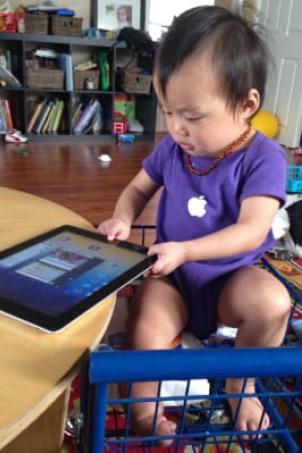
Searching the adoption agency’s website, they found 1-year-old Zi Qin in an orphanage in the city of Luoyang, in central China. The girl, to whom they would give the name Fiona, suffered from amniotic banding syndrome, wherein stringy bands of tissue form on a baby’s body in utero, wrapping around limbs, making deep creases in the skin, obstructing circulation, and deforming legs, feet, arms and fingers, potentially to the point of severing them.
Fiona suffered banding on all her extremities. The right leg got the worst of it, growing to a much shorter length than the left, with a misshapen foot on the end of it that was hardly a foot at all, but a swollen, calloused “blob,” as Angie describes it, that Fiona would drag around, unable to slip a shoe over it. She would bend her left leg to nearly 90 degrees to compensate for the shorter right leg and allow her right foot to touch the ground. She walked in kind of a crouch, Angie says, “like a pirate.”
When Angie and Rob arrived in China late in 2013 to receive Fiona, they were taken by how little she was. “She was 2 years old and like 14 pounds,” Angie says. “The smallest kid of all of them.”
She wasn’t malnourished, just tiny. She would cup her food in her hand as if trying to shield it, a habit Angie took as an indication that the bigger kids in the orphanage would steal from her. “We’d get a muffin at the hotel buffet and she would hold it for three or four hours till it finally started crumbling in her hand. I think she was trying to hide more for later.”
Once home in Santa Clarita, Angie brought Fiona to CHLA to see orthopedic surgeon Deirdre Ryan, MD, and plastic surgeon Joan Wright, MD. She anticipated the right foot couldn’t be saved. “You could just see that no brace or anything was going to shape it into a usable foot,” she says.
Nor was the way Fiona walked viable for very long, Ryan explains: “If you walk on the side or top of the foot, the skin is more likely to break down and you can get infections and other problems.” Replacing the foot with a sturdy, weight-bearing surface, Ryan says, “is sometimes just easier for lifelong well-being.”
Before Ryan could operate, the amniotic banding had to be treated. In May 2014, using a plastic surgery technique called a Z-plasty, Wright cut away the abnormal tissue and leveled out the deep indentations created by the bands, leaving behind just some faint scarring.
After allowing several months for Fiona’s skin to heal, Ryan moved ahead with amputating her right foot. Angie says they tried to make it a happy occasion, imagining for Fiona the new capabilities she would have with her powerful new prosthesis. “We told her, ‘You’re going to get a robot leg, you’re going to be able to wear two shoes, and you’re going to be able to ride a bike,” she says. “The thing that stuck with her most was getting to wear two shoes.”
For Ryan, every amputation takes a toll. “Emotionally it’s difficult,” she says. “You never like cutting something off of somebody. But I know it was the right thing to do for her. She’s functioning fantastically, much better now than when she was having to walk on top of a malformed foot.”
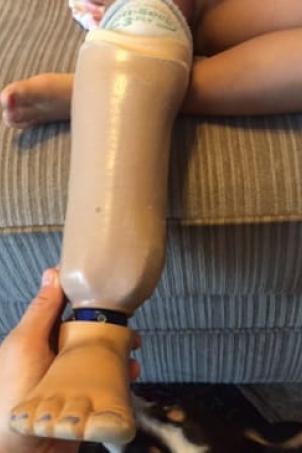
Four months after the surgery, Fiona received her prosthetic leg. “She was up and walking around in five minutes,” Angie says. “She wore it to preschool the next day.”
It fits atop her existing portion of a right leg and adjusts to the same length as the left, and includes a foot that fastens onto the end of it. She’s now on her fourth detachable foot, having cracked and worn out the previous three with her energy and lack of regard for instructions. She flies around on it without any hesitation or limp, only pausing to groom it. “She sits and paints the toenails,” Angie says. “Usually it doesn’t look that great because she does it herself.”
Wright says that any well-intentioned pity is misspent on Fiona. “We all look and say, ‘Oh, gee, how sad,’ while Fiona is oblivious and thinks, ‘Wow! Life is fun!’
“You have to look at it from her standpoint,” Wright says, noting that all Fiona has ever known is one fully functioning leg. Two might baffle her. “She’d think, ‘How would it even work if you had two good legs? How would you walk with those?’”
She knows she has a leg that’s different, Angie says, “but I don’t think she knows it’s supposed to matter that it’s different.”
Certainly it doesn’t matter to her. She dances, rides a bike, works a scooter. “Basically,” Ryan says, “she’s unstoppable.”
No surgery is planned to address her fingers, most of which are stubs, casualties of the banding. “In the fingers you want feeling,” Wright says. “A prosthesis would get in her way and she wouldn’t use it. It’s like a Halloween hand. Put one of those hands on and try to do things. The rubber is in the way and you can’t really feel things, so you take it off as soon as you can.”
As is, she manages just fine. Fortunately, the one digit to develop in full on both hands was the thumb. She pinches it with the other partial fingers to grasp things. “As far as she knows, she’s completely functional,” Angie says. “She can draw, cut with scissors—do everything.”
One exception is gripping the monkey bars on the school playground. That’s not a bad problem to have, Angie says. “We’re fine with her not being able to do that.”
At this point, Fiona’s orthopedic issues are secondary. “Right now the bigger deficit is behavior,” Angie says, laughing. “She has a habit of hiding in the racks at Target and refusing to tell me where she is. Things like that.”
Plus, there’s her fondness for removing the prosthesis and throwing it at her mom from the back of the car. “She knows that it gets a rise out of me if she throws it at me ‘cause I don’t want it to crack and break any more than it already has.”
In sum, their new normal seems quite … normal.
“We’ve reached a point where we’ve forgotten all the disabilities she had and realized she’s just kind of an obnoxious 4-year-old.”
